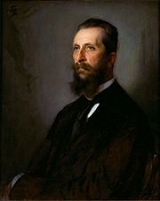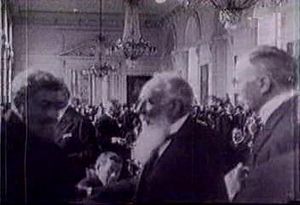
Albert Apponyi
Encyclopedia

Vienna
Vienna is the capital and largest city of the Republic of Austria and one of the nine states of Austria. Vienna is Austria's primary city, with a population of about 1.723 million , and is by far the largest city in Austria, as well as its cultural, economic, and political centre...
, where his father, Count György Apponyi, was the resident Hungarian Chancellor
Chancellor
Chancellor is the title of various official positions in the governments of many nations. The original chancellors were the Cancellarii of Roman courts of justice—ushers who sat at the cancelli or lattice work screens of a basilica or law court, which separated the judge and counsel from the...
at the time. Count Albert Apponyi became a member of the Hungarian Parliament in 1872 and remained a member of it, with one short exception, until 1918. From the late 1880s, he was the leader of the “united opposition,” which consisted of all parties hostile to the Austro-Hungarian Compromise of 1867.
He was Speaker of the House of Representatives of Hungary from 31 October 1901 to 6 November 1903.
As the minister of education he drafted the laws passed in 1907 in which the process of forceful Magyarization
Magyarization
Magyarization is a kind of assimilation or acculturation, a process by which non-Magyar elements came to adopt Magyar culture and language due to social pressure .Defiance or appeals to the Nationalities Law, met...
culminated. Reading, writing and counting in primary schools was done exclusively in Magyar
Hungarian language
Hungarian is a Uralic language, part of the Ugric group. With some 14 million speakers, it is one of the most widely spoken non-Indo-European languages in Europe....
for the first four years of the pupils' education. They became known as the Apponyi laws.
After World War I, Apponyi’s most notable public office was his appointment in 1920 to lead the Hungarian delegation to the Versailles Peace Conference to present Hungary
Hungary
Hungary , officially the Republic of Hungary , is a landlocked country in Central Europe. It is situated in the Carpathian Basin and is bordered by Slovakia to the north, Ukraine and Romania to the east, Serbia and Croatia to the south, Slovenia to the southwest and Austria to the west. The...
’s case to the Allied and Associated Powers
Allies of World War I
The Entente Powers were the countries at war with the Central Powers during World War I. The members of the Triple Entente were the United Kingdom, France, and the Russian Empire; Italy entered the war on their side in 1915...
assembled there to determine the terms of the peace treaty with Hungary, which subsequently became known as the Treaty of Trianon
Treaty of Trianon
The Treaty of Trianon was the peace agreement signed in 1920, at the end of World War I, between the Allies of World War I and Hungary . The treaty greatly redefined and reduced Hungary's borders. From its borders before World War I, it lost 72% of its territory, which was reduced from to...
on account of it having been signed in the Grand Hall of the Palace of Trianon
Grand Trianon
The Grand Trianon was built in the northwestern part of the Domain of Versailles at the request of Louis XIV, as a retreat for the King and his maîtresse en titre of the time, the marquise de Montespan, and as a place where the King and invited guests could take light meals away from the strict...
. In the event, Apponyi’s mission to Versailles
Versailles
Versailles , a city renowned for its château, the Palace of Versailles, was the de facto capital of the kingdom of France for over a century, from 1682 to 1789. It is now a wealthy suburb of Paris and remains an important administrative and judicial centre...
was in vain as the Allies refused to negotiate the terms of the peace treaty.
Between 1911–1932, he was five times nominated for the Nobel Peace Prize
Nobel Peace Prize
The Nobel Peace Prize is one of the five Nobel Prizes bequeathed by the Swedish industrialist and inventor Alfred Nobel.-Background:According to Nobel's will, the Peace Prize shall be awarded to the person who...
by Hungarian universities, scientists and political groups, but never became a laureate.
Count Apponyi was a noted orator and had wide ranging interests outside politics, encompassing linguistics (he was fluent in six languages), literature, philosophy and music. He visited the United States of America a number of times, first in 1904 and last in 1924, where he engaged in lecture tours and befriended leading public figures, including Presidents Theodore Roosevelt
Theodore Roosevelt
Theodore "Teddy" Roosevelt was the 26th President of the United States . He is noted for his exuberant personality, range of interests and achievements, and his leadership of the Progressive Movement, as well as his "cowboy" persona and robust masculinity...
and William Howard Taft
William Howard Taft
William Howard Taft was the 27th President of the United States and later the tenth Chief Justice of the United States...
. Apponyi described his impressions of America in his autobiography The Memoirs of Count Apponyi, published by Heinemann (London), 1935. He was also the author of the book Esthetics and Politics, the Artist and the Statesman. He died on 7 February 1933, in Geneva, where he was waiting at the time to attend the re-opening of the League of Nations
League of Nations
The League of Nations was an intergovernmental organization founded as a result of the Paris Peace Conference that ended the First World War. It was the first permanent international organization whose principal mission was to maintain world peace...
Disarmament Conference.
Works (selected)
- 1889: Parlamentarismusunk veszedelme, őszinte szó Apponyi Albert Grófról. Budapest
- 1895: Aesthetika és politika, művész és államférfiu (Esthetics and Politics, the Artist and the Statesmen), Budapest
- 1896: Apponyi Albert gróf beszédei. 2 vols. Budapest
- 1908: A Brief Sketch of the Hungarian Constitution and of the Relations between Austria and Hungary. Budapest
- 1911: Lectures on the Peace Problem and on the Constitutional Growth of Hungary: lectures. Budapest: St. Stephen's Printing Press
- 1912: Magyar közjog osztrák világitásban. Budapest
- 1915: Austria-Hungary and the War, New York: Austro-Hungarian Consulate-general. Co-authors: Albert Apponyi, Ladislaus Hengelmüller von Hengervár, Konstantin Theodor DumbaKonstantin DumbaKonstantin Dumba , was an Austro-Hungarian diplomat serving as its last accredited Ambassador to the United States and famous for having been expelled during World War I following accusations of espionage.- Life :Born in Vienna on 17 June 1861 as the son of Nikolaus Dumba , a wealthy Greek...
, Alexander Nuber von Pereked - 1922: Ötven év, ifjukorom--huszonöt év az ellenzéken. Budapest: Pantheon irodalmi intézet r.-t
- 1922: Emlékirataim. Ötven év Apponyi Albert gróf. Második, átnézett kiadás. 2 vols. Budapest, 1922, 1934.
- The Memoirs of Count Apponyi. 312 p. London: Heinemann, 1935
- 1925: Gróf Apponyi Albert hét előadása a magyar alkotmány fejlődéséről. Budapest
- 1928: Justice for Hungary: review and criticism of the effect of the Treaty of Trianon. 376 p. London: Longmans, Green (one of several contributors)
Ancestors
| Count Albert György Apponyi de Nagy-Appony | Father: Count György Apponyi de Nagy-Appony |
Paternal Grandfather: Count György Apponyi de Nagy-Appony |
Paternal Great-grandfather: Count Antal György Apponyi de Nagy-Appony |
| Paternal Great-grandmother: Countess Maria Karolina von Lodron-Laterano-Castelromano |
|||
| Paternal Grandmother: Countess Anna Zichy de Zich et Vásonkeö |
Paternal Great-grandfather: Count Ferencz Zichy de Zich et Vásonkeö |
||
| Paternal Great-grandmother: Countess Maria Anna Kolowrat-Krakowsky |
|||
| Mother: Countess Juliánna Sztáray de Nagy-Mihály et Sztára |
Maternal Grandfather: Albert Sztáray de Nagy-Mihály et Sztára |
Maternal Great-grandfather: Mihály Sztáray de Nagy-Mihály et Sztára |
|
| Maternal Great-grandmother: Mária Anna Eleonora Eszterházy de Galántha |
|||
| Maternal Grandmother: Franziska Károlyi de Nagykároly |
Maternal Great-grandfather: József Károlyi de Nagykároly |
||
| Maternal Great-grandmother: Maria Elisabeth Johanna von Waldstein-Wartenberg |
----

